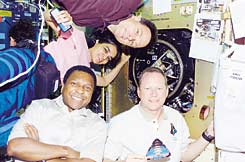17 years after the Challenger space shuttle disaster, the US space agency suffers another blow, the consequences of which for the US space program and the international space programs could be devastating
By: Reuven Fedhzor
 Four of the people of Colombia, last week. Due to the high altitude, the astronauts had no chance of falling
Four of the people of Colombia, last week. Due to the high altitude, the astronauts had no chance of falling
17 years after the Challenger space shuttle disaster, the American space agency suffers another blow, the consequences of which for the American space program and the international space programs could be devastating.
What began as a routine mission - the 107th launch of space shuttles - and was supposed to end in another routine and safe landing of the space shuttle Columbia, ended in an unexpected disaster. It is, of course, difficult at this stage to determine the reason or reasons that caused the breakup of Columbia, and it is possible that NASA researchers will have difficulty determining this later as well, because large parts of the shuttle burned on their way to the ground, and others were severely damaged when they hit the ground.
It can be estimated that the disaster could have been caused by four main reasons. All of them are related to the location and timing of the breakup of the shuttle, which is the most dangerous point in the process of its return to Israel. It means the moment of entry from space into the atmosphere. The shuttle passes from space - an area where there is no resistance and friction for the body flying in it - into the atmosphere where it encounters enormous resistance and friction, which causes a lot of warming. The temperature of the shuttle during the phase of entering the atmosphere reaches about 1,200 degrees. Due to the friction, the heat around the shuttle is great, until it prevents even the ability to transmit radio transmissions from the shuttle outside.
To prevent the shuttle from burning, its outer parts, which come in contact with the atmosphere, are equipped with ceramic tiles, which are supposed to absorb the heat and insulate the shuttle's body. One of the theoretical possibilities at this point is that many ceramic tiles fell from the shuttle upon entering the atmosphere or even before. In such a case, the enormous heat may cause serious damage to the shuttle, and even cause parts of it to disintegrate.
In the photographs of the Columbia mirror, one of the ceramic tiles is clearly seen falling out of place. However, this is not the first case of a tile falling from shuttles during takeoff, and NASA decided that this did not endanger Colombia. However, it is possible that the falling of this tile was only the beginning of a chain process, during which more tiles fell, which exposed the spacecraft to the high and dangerous temperatures upon entry into the atmosphere.
Another theoretical possibility is related to the fact that Columbia is the oldest space shuttle that took off for the first time - already 21 years ago in 1982. Columbia's "extreme" discovery has recently raised question marks in the US, and quite a few experts have warned against further use of such an old space shuttle, due to The fear of the fatigue effects of the material on the integrity of her body. It is possible, therefore, that during the entry into the atmosphere one of the parts of the shuttle failed and broke.
A third possibility that can be raised is that the computer that determines the flight path and the angle of entry into the atmosphere failed, and the shuttle entered the atmosphere at the "wrong" angle, which caused the breakup.
Another possibility can be raised, although its chances are lower, that it is human error. According to this opinion, it was the action of astronauts that caused the Columbia to deviate from the planned trajectory, and to enter "unsmoothly" into the atmosphere, something that could cause damage.
The breakup happened at an altitude of more than 60 km, just after communication with the shuttle was cut off due to the high heat mantle. The connection, which was supposed to be renewed shortly after, was apparently not renewed at all, and this will make it even more difficult to find the cause of the disaster. This is because the astronauts did not have time to report any problem.
Due to the enormous height at which the disaster occurred, the astronauts had no chance of falling, even if they survived the breakup. The ability to exit the shuttle and parachute, an ability developed by NASA in cases where there is a malfunction in the shuttle, actually exists only at a relatively low altitude of 30 feet (about 9 km) and below. The chance of staying alive was small anyway, because the speed of the shuttle at the time it disintegrated was about 26 times the speed of sound, and of course it is impossible to survive at such a speed, even if you manage to get out of the shuttle.
The disaster will have a very serious impact on the American space programs, and the damage to the manned launch program may be fatal. In any case, the space shuttles will be grounded for a long time, until the reason for the breakup of the Columbia is found. Since it is not clear whether the cause will be found, it may not be possible to cancel the grounding.
The disaster will also severely damage the International Space Station project, in which, in addition to the US, other countries are partners. The space shuttles were supposed to be used as a means of communication between the Earth and the space station, and to transport astronauts and equipment to it. Now NASA will have to find a replacement for this.
